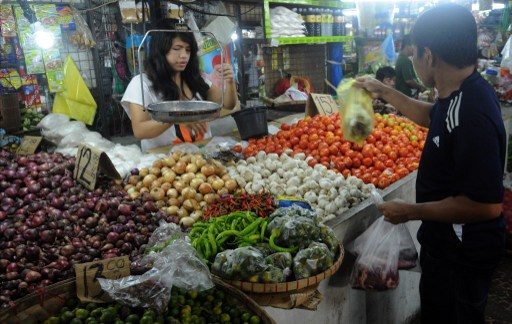SUMMARY
This is AI generated summarization, which may have errors. For context, always refer to the full article.

MANILA, Philippines – Inflation or the movement of prices of basic goods and services eased to a 4-month low of 3.1% in May, amid slower price adjustments in both food and non-food commodities.
This is compared to the inflation rate of 3.4% recorded in April, based on data from the Bangko Sentral ng Pilipinas (BSP).
BSP Governor Amando Tetangco Jr said inflation last month was within the central bank’s forecast range of 2.9% to 3.7%.
“The deceleration to 3.1% from April’s 3.4% was traced to slower increments in the prices of food, beverages, and tobacco items,” he said.
This was the lowest since the consumer price index averaged 2.7% in January this year. Inflation in the first 5 months of 2017 averaged 3.1%, well within the 2% to 4% target set by the BSP.
“The inflation print further supports our view of manageable inflation that is expected to fall within the target range for this year and next,” Tetangco added. (READ: PH seen to remain fastest-growing economy in ASEAN-6 for 2017)
Tetangco’s last rate-setting
Monetary authorities will closely monitor domestic and external developments ahead of the last rate-setting meeting of the outgoing BSP chief and Monetary Board chairman scheduled on June 22.
“The BSP will continue to monitor developments here and overseas that can potentially influence future inflation and consider these in our next policy meeting,” Tetangco said.
Tetangco, 64, is set to end his unprecedented two 6-year terms on July 2. He will be succeeded by BSP Deputy Governor Nestor Espenilla Jr.
Based on its latest assessment, the BSP’s Monetary Board sees the consumer price index averaging 3.4% this year and 3% next year.
Data released by the Philippine Statistics Authority (PSA) traced the decline in inflation to slower annual increments by various commodity groups led by food and non-alcoholic beverages; alcoholic beverages and tobacco; clothing and footwear; furnishing, household equipment, and routine maintenance of the house; health; communication; as well as recreation and culture.
The index for restaurant and miscellaneous goods and services moved up at a faster rate; while the indices for housing, water, electricity, gas, and other fuels as well as education retained their April rates.
The annual gain of the food index alone slowed down to 3.8% in May from 4.3% in April.
Upward pressure
Tim Condon, ING Bank chief economist in Asia, said inflation last month surprised on the downside.
“A high base effect has kicked in [for] the food component; we expect it to be a source of disinflation for the rest of the year. We also think the oil price-driven increases in the utilities and transport components have peaked,” he added.
Eugenia Victorino, economist at ANZ Bank, said inflation has persisted in the upper half of the central bank’s 2% to 4% target range for 4 months as the economy continues to fire on all cylinders, keeping the upward pressure on headline inflation.
“Both headline and core inflation undershot expectations in May… Underlying price pressures remain in the Philippines on the back of strong economic growth,” she said.
Economic managers still expect a gross domestic product (GDP) growth of between 6.5% and 7.5% this year as the expansion slowed down to 6.4% in the 1st quarter of 2017 from 6.6% in the 4th quarter of 2016.
Robust domestic demand and the benign inflation environment have allowed the BSP to keep an accommodative policy stance since September 2014, when it last raised interest rates by 25 basis points. – Rappler.com
Add a comment
How does this make you feel?
There are no comments yet. Add your comment to start the conversation.